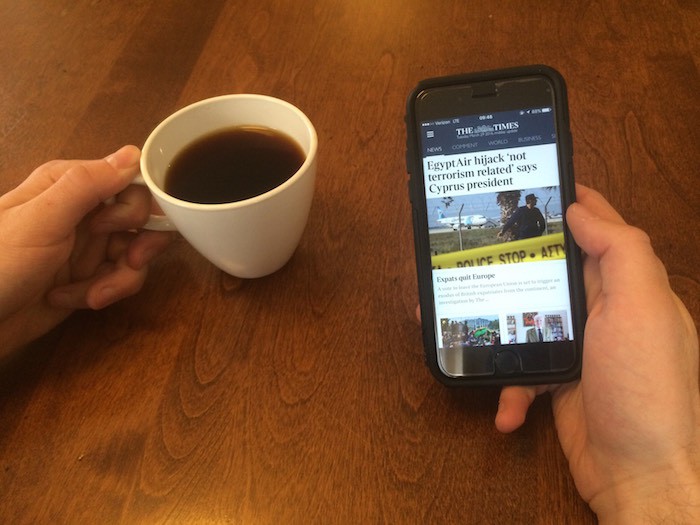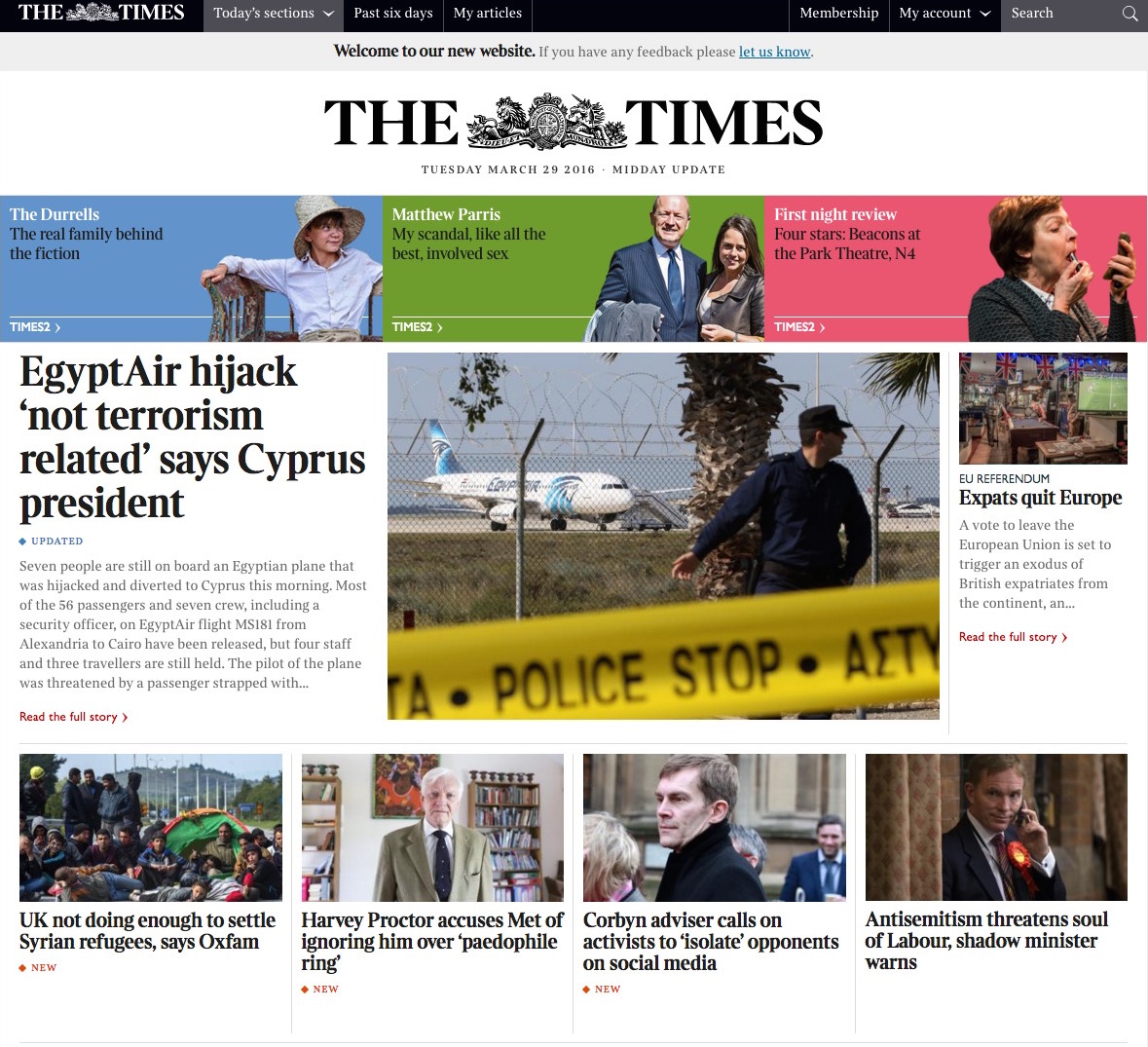
The Times of London and Sunday Times on Wednesday launched new phone and tablet apps, and a new website, all focused on publishing online in editions that will be updated four times a day.
There will be a fresh issue early in the morning, followed by updates at 9 a.m., noon, and 5 p.m. — all times when the Times’ traffic tends to peak as readers wake up, arrive at work, eat lunch, and commute home.
“Our goal is to do editions everywhere,” Times head of digital Alan Hunter told me. “We’ll do editions in print, in tablet, on the smartphone, and on web.”The bulk of the content will be published in the first early-morning edition, but stories will be added and updated as needed throughout the day.
“Hitting these times gives us a great opportunity to report more in-depth, to get things right, to provide analysis on the breaking news that happens throughout the day, but also to serve readers at the times they want it,” Hunter said. “They want a package of news so they feel up-to-date. We recognize that people might check their smartphones a hundred times per day, but they’re not checking for news a hundred times per day.”
 Though the Times and Sunday Times are separate papers with distinct editorial staffs, they’ll now publish on the same website. The papers, which are owned by Rupert Murdoch’s News Corp., already shared tablet and phone apps.
Though the Times and Sunday Times are separate papers with distinct editorial staffs, they’ll now publish on the same website. The papers, which are owned by Rupert Murdoch’s News Corp., already shared tablet and phone apps.
The Times and Sunday Times are both published behind a hard paywall, and it’s difficult to read their content without paying for it.
The Times has a print circulation of about 400,000, while The Sunday Times has a print circulation of about 770,000. As of June 2015, the Times had 158,000 digital subscribers, a 1 percent increase. The papers notched a £10.9 million pre-tax ($15.55 million USD) profit in the fiscal year ending June 2015.
The paywall has, understandably, limited the Times’ online reach. The Times was the 110th most-trafficked media publisher in the U.K. last year, with 64 million pageviews, according to the London-based analytics firm SimilarWeb.
The BBC was the most popular site, with nearly 19 billion pageviews from British visitors in 2015, SimilarWeb said. Fifty-six percent of Britons who go online for news visit the BBC’s apps or website, according to a report from the British communications regulator.
“How do we compete with that market-dominating entity? We looked at what we do well, and we spoke to our readers,” Hunter said.
 The Times spent a year and a half developing its new products. Working with a consultant, it conducted 12 weeks of interviews and discussions with staffers, current readers, and potential future readers before it even began coding any of the products, said Nick Petrie, deputy head of digital.
The Times spent a year and a half developing its new products. Working with a consultant, it conducted 12 weeks of interviews and discussions with staffers, current readers, and potential future readers before it even began coding any of the products, said Nick Petrie, deputy head of digital.
“One of the first questions we asked ourselves was: Okay, so the tablet is an edition, and the tablet is very successful,” Petrie said. “What is it about an edition that people like so much?”
About 76,000 subscribers read the Times’ tablet apps Monday through Saturday, and about 95,000 people use the app on Sundays, Hunter said. On average, readers spend about 45 minutes with the Times’ tablet app on weekdays, and spend more than 65 minutes with it on Sundays. The Times’ website averages 1.2 visits per reader per day.
“It’s finite. It’s finishable. It’s a clear package that contains a breadth of content, but also depth where appropriate. It’s easy to navigate, clearly delineated,” Petrie said. “These things were plastered all over the walls as the initial design phase was going on. You can’t possibly get your head around the number of Post-it notes this project has gone through.”
Other news organizations, such as Quartz and The Economist, have created finite products, because readers often say they’re overwhelmed by the unending stream of content found online.Similarly, the Times’ focus on editions has permeated beyond its core products. In January, it introduced a paid weekly app that curates the best from the Times and Sunday Times and is aimed at an international audience.
“We’re a paid-for proposition in a market where practically everyone else is free,” Hunter said. “We think breaking news is commoditized. It’s very difficult to make people pay for breaking news, and we’re emphatic in our belief that quality journalism should be paid for.”
Reader feedback led the Times to design its website as one long scrolling page instead of a homepage with separate section pages. “Readers told us they wanted to find things very simply and easily, and that was the most important thing,” Hunter said.

The Times’ research also helped it decide to emphasize its slower, edition-based approach. It will be ditching features like live blogs, which analytics and interviews suggested readers weren’t fans of.
That’s not to say the Times won’t cover breaking news, but unless it’s a major story (“The way it’s framed in the U.K. is: What happens if the Queen dies?” Hunter said), it likely won’t break its digital publishing schedule.
“Our strengths lie in actually saying — whether it’s an hour or two hours later — here’s a definitive read on what’s happened so far, rather than just pulling in tweets of condolences from presidents and prime ministers around the world,” Petrie said. “We think very much about what service we owe our readers rather than what we want to do as publishers.”
Times journalists will still have plenty to keep them busy. They now have distinct deadlines to hit throughout the day. While reporters won’t be asked to file constantly for each deadline, some staffers have begun working different hours to accommodate the new schedule.
Their work will now appear in more places, too. Previously, the Times didn’t publish every story across its sites and apps, but its research showed that readers wanted to be able to read anything wherever they wanted.
“[The old app] was designed with the prevailing mentality that smartphones were for snacking,” Hunter said. “We think that has moved on, and people were saying to us, ‘I want to read that 3,000-word piece you had on Naomi Campbell in the magazine this weekend. Where is it?'”
The Times also commissioned a new font — Times Digital — for the apps and site, which is meant to be read on screens. (Fun fact: The Times actually commissioned the creation of Times New Roman in 1931, when it was looking for a font that was easier to read on newsprint.)
Even as the apps and site roll out, the Times plans to continue tweaking them. Rebekah Brooks, the controversial CEO of News UK, wants them to be in “perpetual development,” Hunter said.
“We’re going to take reader feedback now and for the rest of time,” he said.